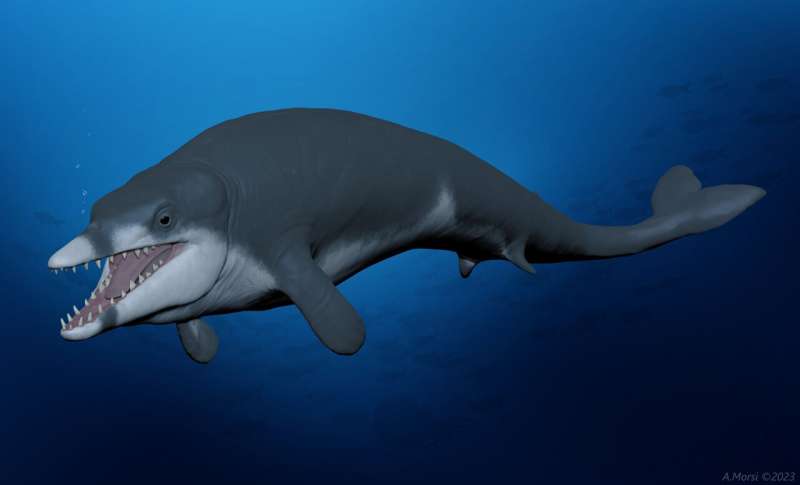August 12, 2023 feature
This article has been reviewed according to Science X's editorial process and policies. Editors have highlighted the following attributes while ensuring the content's credibility:
fact-checked
peer-reviewed publication
trusted source
proofread
Saturday Citations: Muons and the standard model, refuting an apocalypse, stellar tidal waves

This week on phys.org, we published news about muons, gigantic stellar waves, a Homo-erectus-thwarting mini ice age, and a new whale guy.
Particle wobbles: Macro-scale physicists have achieved nanoscale precision measurements of the muon anomalous magnetic moment as part of a decades-long agenda of shaking the standard model and shouting "Are you complete yet?" The unforthcoming standard model has stubbornly refused to explain subatomic phenomena like dark matter, and scientists have been searching at increasingly smaller scales for particles within the standard model that could account for them. One such mystery: If you run muons in circles around a powerful magnet, they wobble, decaying in unexpected directions. This is the anomalous magnetic moment. It's possible that undiscovered particles nudge muons under these conditions. Does this latest project, the Muon g-2 experiment, resolve the question? Haha, no. But it does confirm earlier findings at a much higher level of precision, which is a pretty big deal, at least according to physicists, to whom "big" is, like, the size of an electron.
New whale guy: If you relate emotionally to organisms that crawled from the ocean to the land, said "lol, no," and waddled back into the sea forever, a new whale guy just dropped. An international team of scientists discovered an extinct whale that inhabited the Tethys Ocean, an ancient sea that once covered modern Egypt. They've named it after notable 18th-dynasty pharaoh Tutankhamen. Tutcetus ratanesis is a basilosaurid, an extinct family that lived during the middle to early late Eocene. Tutcetus is the smallest species of basilosaurid ever discovered, expanding the size range of the family and illuminating early whale evolution.
Apocalypse Not: In 2022, researchers led by Dr. Kenneth Tankersley published a sensational paper in Scientific Reports claiming that the Indigenous Hopewell culture, which thrived around what is now Cincinnati, was destroyed by an exploding comet 1,500 years ago. OK! One and a half years later, archaeologists at Ball State University say that not only is the word "destroyed" doing some heavy lifting, the words "by," "an," "exploding" and "comet" are similarly load-bearing structural elements. In their response paper, also published in Scientific Reports, researchers including Dr. Kevin C. Nolan basically challenge all of the individual words in the original paper.
"There is no evidence for catastrophically burned habitations at any of the 11 Hopewell sites studied by Tankersley's team," Dr. Nolan said. "The burned surfaces identified by the University of Cincinnati researchers are either localized episodes of burning for ceremonial purposes, such as cremating the honored dead, or are not even burned surfaces at all." Fair enough! The response paper also carefully details "numerous instances of possibly intentional data manipulations."
Earth inhospitable: In the midst of a planetary heatwave, it's easy to think, "a massive North Atlantic cooling event would be pretty good right now." Contrariwise, Archaic Homo erectus individuals living in western Europe about 1.5 million years ago may very well have said, "Bro, you do not want to live through an ice age." Citation: a study published in Science by an international group of scientists reporting that a massive North Atlantic cooling event shifted the climate just as good old Homo erectus was starting to get a foothold in the hemisphere. "This massive cooling marks one of the first terminal stadial events in the paleoclimatic record. It occurred during the last phase of a glacial cycle, when ice sheets disintegrated, releasing large amounts of freshwater into the ocean, and causing ocean circulation changes and a southward expansion of sea ice," says Prof. Chronis Tzedakis from University College London (UCL), senior author of the study.
The researchers built a global climate simulation correlating ocean sediment core data and computer simulations of glacial freshwater flows. They used the model as input for a human habitation model, finding that early human species would have been unable to survive. Indeed, the paleontological record indicates the absence of stone tools and human remains in western Europe over the next 200,000 years. The researchers also point out that this cooling period was "brief," meaning only 4,000 years long, 3,999 years and nine months longer than I'm willing to tolerate the average cold winter. Bro, I do not want to live through an ice age.
Stars: immense. You: insignificant: Researchers at the Harvard-Smithsonian Center for Astrophysics have determined the cause of the extreme swings of brightness in a heartbeat binary called MACHO 80.7443.1718: titanic waves of plasma as tall as three suns crashing on one side.
Heartbeat stars are close pairs of stars with brightness that periodically pulses like the rhythm of a heart. When they approach closely in their oval orbits, their mutual gravity generates tides, stretching and distorting their masses and changing the amount of light visible from Earth. The larger of the two MACHO 80.7443.1718 stars, which is 35 times larger than the sun, exhibits regular brightness swings of 20%, higher than any other known heartbeat star. "Each crash of the star's towering tidal waves releases enough energy to disintegrate our entire planet several hundred times over," says postdoctoral researcher Morgan MacLeod, as though none of us have ever seen the Pale Blue Dot photo and needed further confirmation of the Earth's relative insignificance and vulnerability in an infinite universe of vast energies and immense forces. Have a great weekend!
Journal information: Scientific Reports , Science
© 2023 Science X Network





















